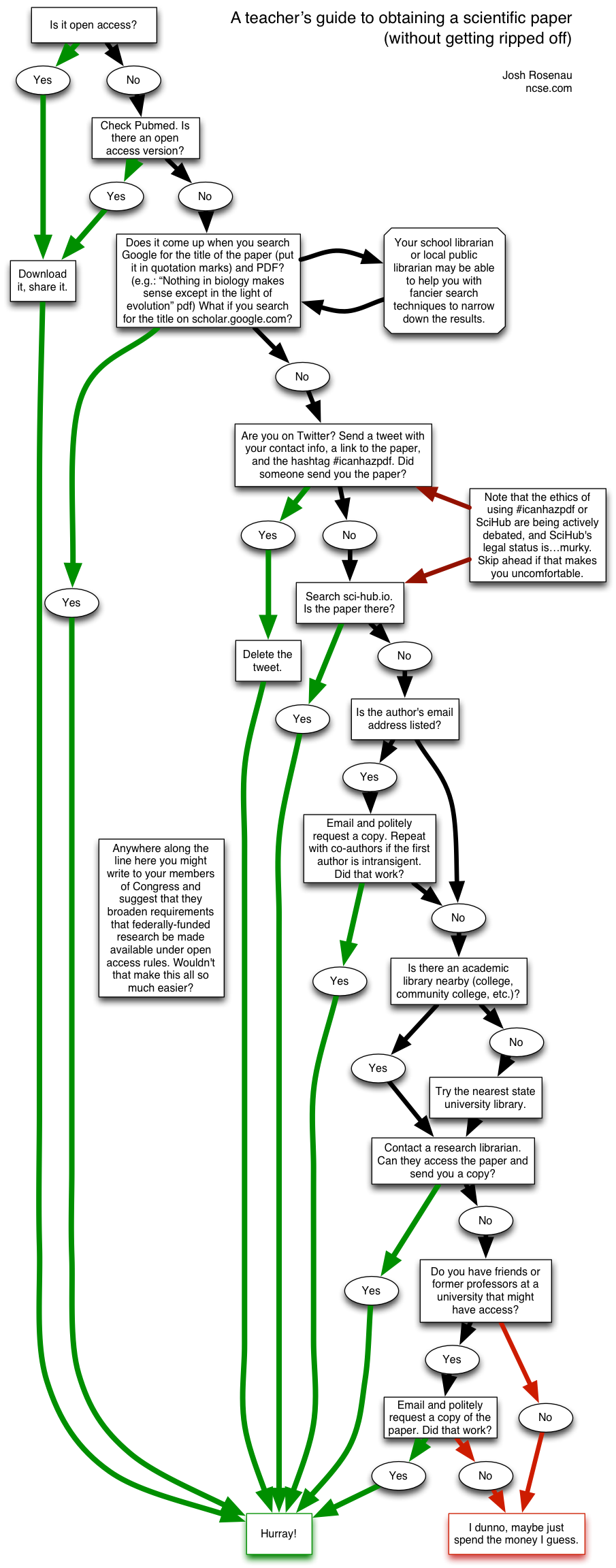A high school teacher e-mailed @cenewman0 asking for a PDF for her class, “embarrassed she couldn’t afford $40”. :( pic.twitter.com/fEIW4ReP1h
— Karen James (@kejames) February 26, 2016
A scientist on Twitter recently posted this request from a teacher, asking for a copy of a research paper the scientist had written:
Yesterday, I was looking through the news and I found an article about a new species of leopard frog that you’ve identified. I was so excited to read your primary article. I have always been interested in herpetology and right now I am teaching my students about evolution, speciation, and determining phylogenetic relationships. Our textbook is 10 years old and I’m always looking for ways to supplement the information that it contains. I went to the website for “Molecular Phylogenetics and Evolution” and found your article. I hoped to read it, try to understand your research, and share it with my students. Unfortunately, it costs $39.95 and I don’t have a school or personal budget to afford it. I gave up last night. However, this morning as I was driving to school, it occurred to me that I could probably find your email address and write you to request a copy of your article. I’m sure that it’s completely worth the $39.95 that they’re charging, I’m just hoping that you’ll extend the courtesy of sending me a copy that I’ll only use for educational purposes. If this request is offensive to you, I apologize. It looks like you’re a teacher and a scientist so I figure it’s worth a try.
The scientist shared the paper, of course.
But I suspect lots of teachers have had comparable experiences, and that many of them never got past “I gave up last night.” I mean, who would pay $40 for a single article? You can buy complete books for that price. Nothing reinforces science’s aloof image quite like seeing a $40 price tag to simply access a single brick in the edifice of science. No wonder the teacher worried the request might seem offensive (it isn’t). Let me reveal one of the great secrets of science:
No one pays $40 for a research paper.
Well, not no one. I’ve never paid sticker price for a paper, but I put out a query to some of my Twitter followers, and people acknowledged that they’ve paid if they were doing consulting work and could have the client pay for it. Journalists on deadline mentioned buying a paper if they needed it right away. Sometimes an article’s authors are dead, retired, or unreachable, and the journal isn’t in a nearby library, so people just bought the PDF. And, of course, teachers and patients trying to understand their medical treatment pony up the exorbitant prices, thinking that’s just how the system works.
 But that $40 price tag is a sham. Scientists know that the authors of a paper don’t see a single cent of that $40, and indeed that the authors may well have been obliged to pay for the privilege of publishing it. They know that most scientists access the paper through an institutional subscription (subscriptions so absurdly expensive that some institutions have threatened boycotts, and are certainly too pricey for a K-12 library), and without personally paying anything for access. As the flowchart to the right shows, there are a range of steps that scientists routinely take, and which teachers can take, too, to access research without paying exorbitant fees.
But that $40 price tag is a sham. Scientists know that the authors of a paper don’t see a single cent of that $40, and indeed that the authors may well have been obliged to pay for the privilege of publishing it. They know that most scientists access the paper through an institutional subscription (subscriptions so absurdly expensive that some institutions have threatened boycotts, and are certainly too pricey for a K-12 library), and without personally paying anything for access. As the flowchart to the right shows, there are a range of steps that scientists routinely take, and which teachers can take, too, to access research without paying exorbitant fees.
First, it’s important to know that there’s a growing movement in support of open access scientific publishing. Journals (or papers in journals) that are published open access are not behind a paywall at all, and if they adhere to the purest principles of open access, they are published under terms that allow reuse of the paper’s contents. That means teachers are free to include figures in their own handouts and slideshows, make all the copies they need, etc., so long as they provide proper citations. And by law, NIH-funded research must be released through PubMed under a more limited form of open access within two years of the paper’s publication. Some publishers also make their papers freely available when accessed from public or high school libraries.
Second, it’s worth noting that PDFs of papers often wind up online, either because the authors posted them or because they were posted for a course reading list, or because the authors submitted the paper to a preprint server like arXiv or bioRkiv (As Seen In The New York Times). The right Google search will turn those up (usually just searching for the title and adding “PDF” to the search, but Google Scholar is also good to check).
Third, scientists are happy to share papers. When I started grad school, the first assignment in a class called “The Art of Becoming a Professional Scientist” was to write to five scientists in our field and ask them for offprints of some interesting papers. That’s how fundamental and routine sharing papers is to the scientific enterprise. Before computers, every department had stacks of postcards that you could just fill out and drop in the mail to ask other researchers for offprints. These days it’s all done by e-mail and PDFs, but the same principle applies. No teacher should ever be ashamed or hesitant just to write to a scientist and ask for a copy of the paper. No scientist should ever refuse such a request (if they do, tell them they’re in trouble with me).
Writing to the scientist has other advantages for a teacher. The authors might have other resources that would help in class. They may have written a more accessible blog post on the paper, or have images more suited for classroom presentation. They may be willing to visit the class, or at least Skype in and do a Q&A. If nothing else, any scientist ought to be happy, time permitting, to walk the teacher through the paper’s jargon and make sure the research comes across clearly and accurately to the students.
In addition, teachers can try searching for the paper on Sci-Hub, or putting out a request for the paper on Twitter. Sci-Hub is, it should be noted, controversial, since the papers available there were posted in violation of the journal’s copyright, and the site has faced litigation in the past and had to move overseas to avoid penalties. The creators describe it as an act of protest against the limited access to the scientific literature for people outside of well-funded research institutions, which isn’t a compelling legal argument, but one which many find morally compelling. Whether or not people feel comfortable in using the site is probably colored by their stance on those broader questions. Asking for papers on Twitter using the #icanhazpdf hashtag is generally pretty reliable, but your mileage may vary.
Beyond that, teachers can likely get a copy of a paper by asking a librarian at a nearby college or university. Librarians love helping with these sorts of requests. Failing that, teachers could ask someone they know on campus to download the paper.
Granted, sometimes all of this just doesn’t turn up the paper. In that case, if the paper is that important, you just have to shell out for it. But in practice, one of the steps outlined above will almost always get teachers what they need, and show them the collaborative and friendly nature of the scientific community to boot.

